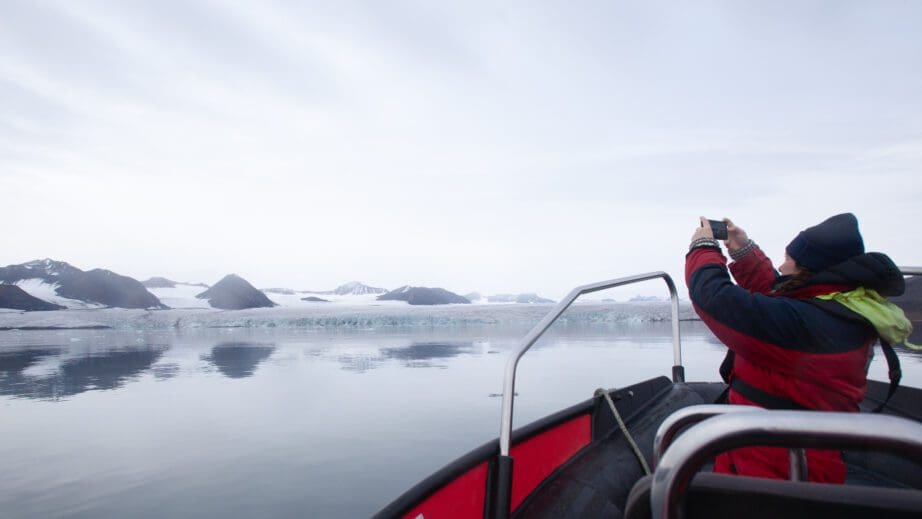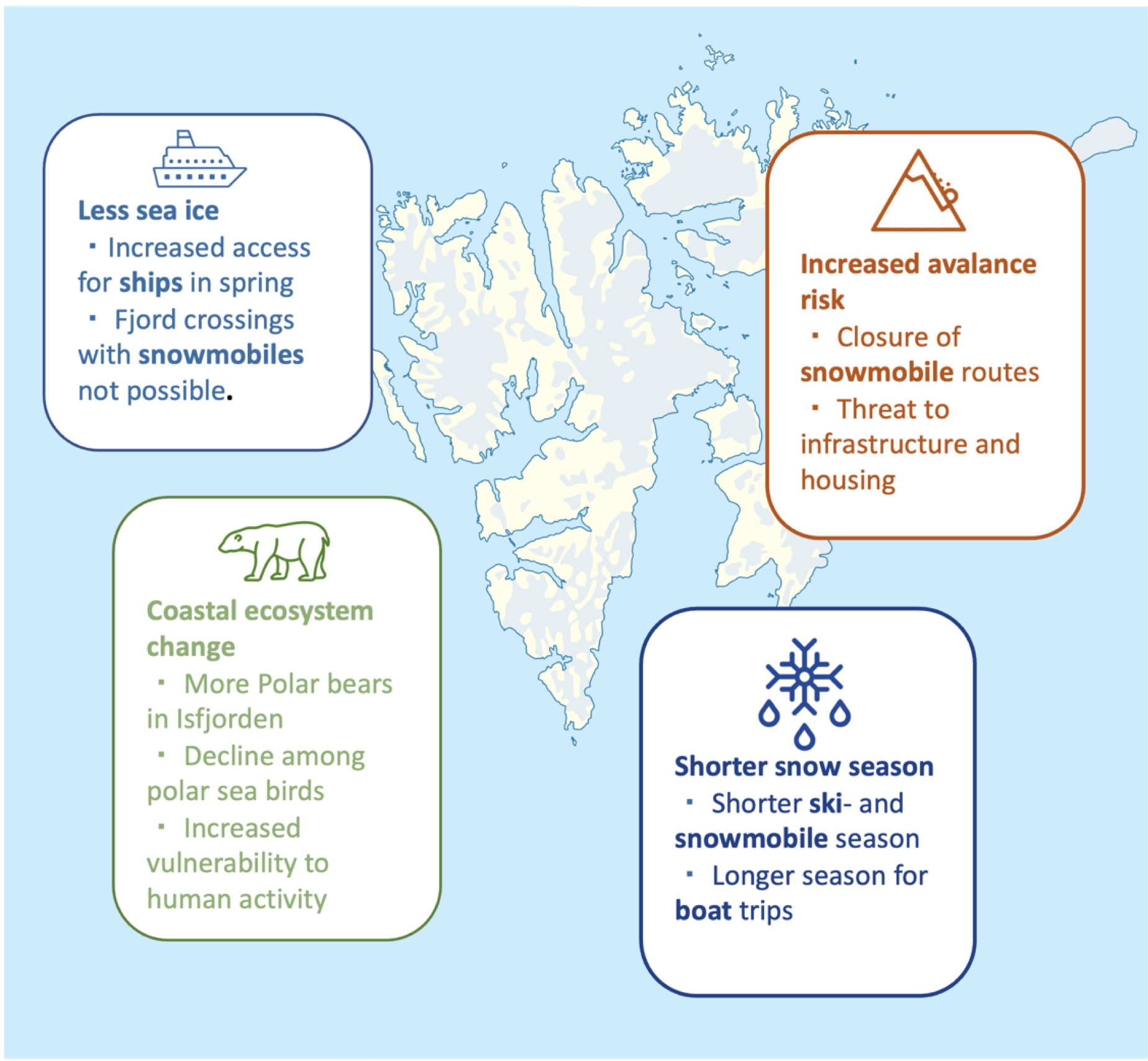Impacts of climate and environmental change on tourism in Svalbard
A report published in Western Norway Research Institute reviews and summarizes the existing literature on climate change and ecosystem change on Svalbard, with particular focus on the consequences of rapidly changing climate and environmental conditions for tourism in the archipelago.

A tourist photographing the glacier front in Borebukta. Photo: Ingrid Ballari Nilssen
Text: Halvor Dannevig, Janne Søreide, Anna Sveinsdottir, Pernille B. Eidesen
You can read the full report here
Svalbard, much like the rest of the Arctic, is experiencing rapidly changing climate and environmental conditions at a rate that far surpasses other regions of the world (Prost et al. 2019). Climate projections indicate that the Arctic will continue to warm faster than the rest of the world in the twenty-first century (Koenigk et al., 2020). Expected consequences of increased Arctic warming include ongoing loss of land and sea ice, threats to wildlife and traditional human livelihoods, increased methane emissions, and extreme weather at lower latitudes (Post et al., 2019).
As the tourism sector relies on natural elements such as sea ice, permafrost, flora, and fauna, as well as physical infrastructure that are directly or indirectly affected by climate change, climate change will have far-reaching consequences for the future of tourism in the Arctic (and elsewhere) (AMAP 2017, Hovelsrud et al. 2011, Scott et al. 2019.
Melting Cryosphere
One of the major impacts of climate change observed in Svalbard, thus far, is the ongoing loss of land and sea ice. Spatial and temporal reduction in sea ice cover has expanded the navigation season and area of operation, which has enabled a demand-driven growth in cruise traffic (Stocker et al. 2020). The sea ice season in the Barents Sea–Svalbard region is getting shorter, and recent studies project that the Barents Sea will be totally ice free by 2040 (Bennett et al. 2020). The changing climate is thus widely believed to enable continued expansion of Arctic marine-based tourism and to lead to opportunity-based adaptation to climate change (Dawson et al. 2016; Olsen et al. 2020). A recent estimate on shipping development around Svalbard indicates that the level of activities will continue to increase toward 2040 (Olsen et al. 2020). In July 2022, a French cruise ship company reached 90 degrees north with tourists for the first time.
Until then, only Russian icebreakers had brought tourists to the North Pole. Cruise ship tourism to the North Pole is thus already a reality (Humpert 2022; Kubny 2022).
At the same time, climate change is causing what can best be described as an emergency response crisis in Longyearbyen (Hovelsrud et al. 2021). An avalanche destroyed (( houses and killed two persons in 2015 (Sokolickova et al. 2022). Subsequent avalanche risk assessment led to the relocation of several residential buildings. Major investments have also been made in landslide protection and flood protection, as well as in reinforcing roads and buildings to withstand thawing permafrost (Meyer 2022). There is also a concern that climate change is making ecosystems and wildlife more vulnerable to negative impacts from human activities (Hovelsrud et al. 202, NEA 2022). Increased human traffic in the far North may introduce new species and potentially harmful microorganisms to the ecosystem (e.g., through ballast water; Goldsmit et al. 2018). Further, the ongoing Atlantification of the marine ecosystem changes the trophic interactions, with increased predation pressure on many Arctic key species, such as polar cod and large-sized Arctic copepods (Misund et al. 2016).

Opportunities for the tourism industry and for the local community
Ongoing changes in Svalbard tourism create numerous opportunities for the tourism industry and for the community of Longyearbyen. These include a shift from seasonal to year-round tourism, the emergence of new markets and tourism segments, and a shift from land-based to marine-based tourism. Additionally, Longyearbyen is increasingly promoted as a tourism destination in and of itself and not only as a transit hub (e.g., Olsen et al. 2020). However, these opportunities are increasingly balanced against climate change impacts, and shifting sustainability requirements and governance procedures.
Tourism regulation on Svalbard addresses the protection of nature in the context of tourism growth (Ministry of Justice and Public Security 2018) by limiting the area for access and passage, setting requirements for organized outdoor activities, and developing regulation instruments, such as environmental taxes (Hovelsrud et al. 2023). The Svalbard Environmental Protection Act (SEPA) stipulates that environmental concerns shall trump economic interests in case of conflict and that large areas will remain unchanged for the purposes of research and monitoring (MoJPS 2016). Meanwhile, Svalbard’s flora, fauna, and cultural remains shall be sustained without influence from human activities, preserving opportunities to experience nature undisturbed by motorized activities, even in the vicinity of settlements (MoJPS 2016). In September 2021, the Norwegian government began a public consultation process1 on suggested amendments to the SEPA and associated regulations.2 The proposed changes signal increased state control (Sokolickova et al. 2022), and the process resulted in significant reactions from
Longyearbyen business operators, the local population, and other actors (Haugli 2022). In January 2023, the Norwegian Environment Agency published their suggested amendments, which maintained the major points in the hearing document, including suggestions to limit the number of passengers on tourism vessels ships to 200 and reduce the number of sites allowed for visitors. The decision by the Norwegian government is awaited with both eagerness and apprehension, depending on one’s point of view.
The rapid changing climate and environmental conditions in the Arctic warrant a greater effort in understanding socio-ecological systems on Svalbard (Øian and Kaltenborn, 2020). However, as of today, there is limited knowledge available about the interplay between human activities, ecosystems, and climate- and environmental change on Svalbard. Moreover, the current scientific knowledge that exists is predominantly characterized by fundamental research that is not necessarily relevant for policy making and management system design. As a result, the precautionary principle and stronger environmental protection prevail in management practices in the archipelago. There is therefore a need for more research that actively contributes to building a scientific knowledge for knowledge-based, rather than precautionary principle-based, management system (Nyseth & Viken 2016: 70).
1 In Norwegian public administration, a consultation process (høringsprosess) is used by a ministry to consult affected parties on suggested laws and regulations, suggested changes in public administration, jurisdiction changes, etc.
2 Norwegian Environment Agency. Amendments to the Svalbard Environmental Protection Act and Associated Regulations on Nature Conservation Areas, Motor Traffic, Camping Activities and Area Protection and Access to Virgohamna, 2021.